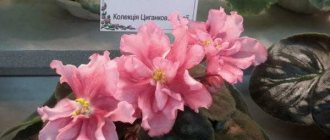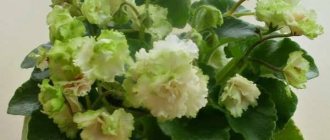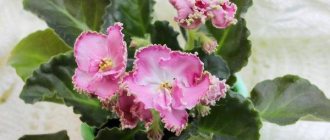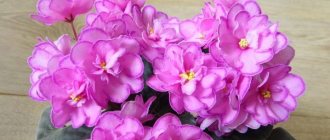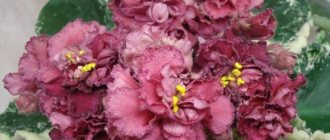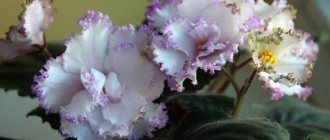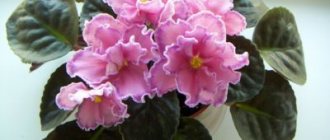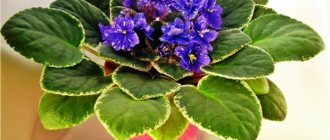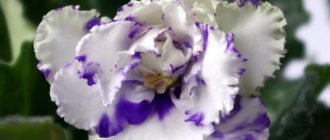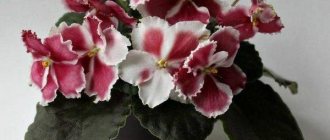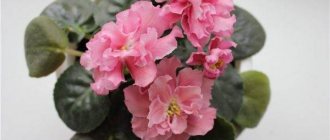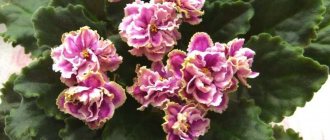In this article you will find a photo and description of the seedling of breeder Konstantin Morev Country of Crimson Clouds SM and read its detailed characteristics.
You will also learn how to properly care for this violet , what conditions are necessary for good growth and flowering. This information will help you avoid common mistakes that lead to disease and death of the plant.
Violet PT-Fiona (T. Pugacheva)
The PT-Fiona variety was introduced in 2013 by breeder from Kursk Tatyana Pugacheva.
A standard rosette with large wavy leaves and white flowers with a green wavy edge .
This variety is a sport from PT-Elenika.
PT-Fiona.
PT-Elenika.
As can be seen from the photo, the main difference between the variety and the sport is a less wavy ruffle and a pink mark in the middle.
The bride's bouquet
The “bridal bouquet” violet is easily recognized by its double, snow-white inflorescences with a wavy edge. The variety's rosette is compact and forms an almost perfect circle. The leaves are dense, dark green.
With long daylight hours, regular watering and comfortable temperatures, the “bridal bouquet” can bloom all year round. The plant grows quickly, so an adult violet will have to be replanted every 6-7 months.
Caring for the variety at home
Like any Saintpaulia, the PT-Fiona variety needs to follow certain rules . You definitely need to remember them.
Lighting
First of all, it is important to provide the outlet with the right amount of light. Lack of lighting leads to lifting of leaves and poor flowering, or even its absence.
The optimal lighting time is 8-10 hours. If the plant lifts its leaves upward, you need to add more lighting time; if the center of the rosette becomes denser, reduce it.
Watering
Watering is carried out when the top layer dries 1 centimeter . If the plant suddenly becomes dry, under no circumstances should you immediately water it with large amounts of water! The socket should be unsoldered literally drop by drop until the root system starts working again.
Choosing a pot
The size of the violet container is 3 times smaller than the outlet. This means that the maximum pot size for an adult rosette is a maximum of 9, a baby or starter will develop perfectly in 100 ml cups.
In a large container, the risk of overflow and root rot increases significantly.
Temperature
Temperature conditions are extremely important for the formation of buds and the correct bright color of Saintpaulia. The PT-Fiona variety prefers temperatures up to 20 degrees maximum . In hot weather, the green border can become completely invisible.
For a large collection, it is optimal to install an air conditioner or fan in the room in the summer, but if this is not possible, place the violet in well-ventilated places with a slight draft.
Top dressing
Fertilizers are extremely important for the development and growth of Saintpaulia. During the period of leaf growth, focus on nitrogen preparations (once a month); as soon as the buds begin to form, you should switch to fertilizing with a high potassium content.
Air humidity
As for humidity, excessive dryness can lead to the appearance of pests (mites), and excessive moisture can lead to rotting .
If the leaves begin to crack or are standing next to heating devices, use a humidifier , jugs of water or radiator-powered bowls.
If humidity is high, ensure good drainage and sufficient cultivators in the soil .
Air humidity is of great importance for violets.
ATTENTION! The preparation for feeding should be diluted a little less than indicated in the instructions!
Priming
And the most important point is the composition of the soil. Violets do not tolerate heavy substrate. The ideal composition is 50 percent high-moor peat and 50 percent ripper (perlite, foam balls).
Wick irrigation involves increasing rippers by another 15 percent. When using this growing method, do not forget about proper planting - the center should be slightly raised.
Pest infestation
Of the pests, violets are most often affected by mites and scale insects. You can use traditional methods, but the effect is stronger from industrial preparations. Breed them strictly according to the instructions and follow safety precautions.
Violet Juice Adelina - Svetlana Dzhura (Pikalenko)
Bright violet Juice Adeline.
JuS-Adeline belongs to the genus of double violets. The flowers often reach 6 centimeters in diameter . Blooms profusely and often. In the case of transplanting an adult plant or propagation, the young sprout blooms already in the sixth or seventh month after transplantation.
Variety, genus, family
This plant belongs to the Saintpaulia variety , the violet genus, and the Gesneriev family.
Origin story
The author of the variety is Svetlana Dzhura (Pikalenko). The variety is considered the queen among the Saintpaulias of the pink palette. Raspberry terry stars with double fringe :
- Burgundy-fantasy;
- White.
Variegated green border:
- Gives the leaves additional charm;
- And it makes the flower even more spectacular than varieties with a single color design.
IMPORTANT! The variety was bred through selection and is the original type of Saintpaulia (author Svetlana Jura (Pikalenko)), which is why mistakes made in caring for the plant or in the conditions of its maintenance can lead not only to deterioration of the condition or diseases of the flower, but also to violation of the varietal characteristics of the variety.
Photo and description
Dark crimson stars with double edging along the edge of the petals:
- The first is burgundy-fantasy;
- The second one is white.
The diameter of the flower can reach 6 centimeters. Medium size socket . The leaves are medium green. This type of Saintpaulia belongs to the variegated varieties, which sets it apart from other representatives of the genus.
The variety has brightly colored flowers.
The double border of the JuS-Adelina flower is a specific feature of this plant.
ATTENTION! With improper care, as well as improper maintenance, there is a risk of its loss during further flowering.
Methods of reproduction, rules of transplantation and rejuvenation
The variety can be propagated by shoots or leaves.
In the first case, the stepsons are carefully separated from the mother's outlet and planted in loose soil (50 ml glass). It is recommended to place it in a greenhouse. Under the right conditions, within a couple of weeks the daughter plant will take root.
Leaves can be rooted both in water and in the ground:
- in the first case , you should use a dark container (medicine bottle) and boiled water. You can add a drop of hydrogen peroxide or a tablet of activated carbon to prevent the stem from rotting. As soon as the leaf has given roots, it is planted in the ground and wait for the babies to appear;
- for more advanced gardeners, you can use the method of rooting leaves in the ground : a leaf is placed in plastic glasses with light soil (cut of the stem at 45 degrees) and lightly sprinkled with earth;
- It is optimal to use a bag or greenhouse for rooting. In the first days, the leaf may lose turgor, this is not scary;
- The soil needs to be moistened immediately after planting, then you can water it drop by drop if it dries out.
Once every six months or after flowering, you need to transplant the rosette into fresh soil. The old substrate is quickly depleted, which harms the plant.
After flowering, the violet should be replanted.
If the rosette has grown a lot, transplant it from the cup to pot 8 or 9:
- We put drainage (expanded clay) on the bottom;
- Pour some earth (see composition above);
- Carefully place the plant;
- Sprinkle with earth and tamp down a little.
about 10 months from the leaf to the blooming young rosette . The first flowering is most often not too abundant, the subsequent ones already produce caps of flowers.
IMPORTANT! You should not bury the violet to prevent the growing point from rotting!
Peruvian lily: briefly about the origin
Peruvian lily: photo of the variety
At the moment, there are a huge number of plants that live for one year or several years. It is very difficult to choose a plant that you like the first time, especially when you have just started gardening. Of course, everyone wants a plant with a stunning appearance, with simple and straightforward care, without spending a lot of time and money. This flower, which is considered unpretentious both in terms of growth and in terms of caring for it, falls under all these criteria.
The Peruvian alstroemeria lily originated on the territory of the South American state. It grows wild in Peru and Chile. At this time, this plant grows in the territory of its native country only near roads, like a weed. You can compare this plant with our dandelions, which are of interest only to children. If you rewind time to the time of the existence of ancient civilizations, for example, during the existence of the Incas, you would notice that this flower was presented as a gift from the sun god Inti.
When the people of Spain explored the lands of America, the flower was transported to Spanish lands, and it began to grow there, but did not attract much attention and was not popular. This continued until the Swedish scientist Clas Alströmer decided in 1760 to travel across the seas and oceans to study the territories of Europe. His path passed through the lands of Spain. Clas Alströmer was interested in exact sciences, botany, chemistry and zoology.
He spent a huge amount of time exploring various herbaceous crops, asking to be allowed to look at personal greenhouses, gardens and collections. While exploring the territory of Europe, he never stopped monitoring the world around him. On the lands of Spain, Clas saw this stunning flower, which he had never seen before. It is worth mentioning that Claes was one of the best students of Carl Linnaeus and his good friend, so it is not surprising that he sent the plant to Carl.
In one thousand seven hundred and sixty-two, Carl Linnaeus finished work with the plants sent to him and created a new family for them, which was named in honor of their discoverer, namely Alströmer. The family became known as Alstroemeriaceae, the species was named Alstroemeria, it included about fifty species. This plant gained immense popularity in Europe; later it was found in almost all greenhouses, gardens and flower beds. Next, we will look at why the plant has won the hearts of gardeners.
Features of flowering, growth and reproduction
The main feature of this variety is the incomplete bloom of flowers in some cases . But this drawback more than makes up for its advantage - the flowers can stay on the peduncles for up to 3 weeks! PT-Fiona is ideal for those who love stable peduncles and long flowering.
PT-Fiona flower.
As for cap flowering, the variety blooms extremely readily in suitable conditions. A mandatory rule is to have sufficient lighting and apply fertilizer at least once every 2 months. All efforts are compensated by a lush green rosette and lush flowers with a bright green ruffle.
In the heat (temperature more than 21 degrees), PT-Fiona loses the brightness of its flowers. To obtain a green ruffle, coolness is important during the period of bud formation and further development.
Rosemary
Due to their splendor, rosemary buds resemble bright pompoms with a diameter of up to 6 cm. Peduncles, consisting of 3-4 ovaries, are located in the center of a large rosette. The diameter of an adult bush reaches 32-35 cm.
The coloring is considered one of the most elegant. White-pink petals are densely strewn with purple splashes and stains. The core is bright yellow. In summer, the whiteness almost completely disappears, and returns again as the temperature drops.
Reviews
You can read the following reviews on the florist forums.
Natalia. “This variety is one of my favorites. I am a beginner, and still Fiona pleased me with an armful of flowers and a compact rosette. A very demanding variety in terms of lighting - the leaves on the western window have begun to stretch out.”
Olga. “Nowhere else have I found such a rich green shade without any dancing with tambourines. Over the course of a year of cultivation, I found ideal conditions - 9 hours of lighting, regular replanting in fresh soil and fertilizing.”
Zhenya. “The flowers do not fully bloom, the rosette sometimes becomes a little uneven. Otherwise, the variety pleased me - it blooms steadily and for a long time. I don’t like collecting “bare” rosettes; I like when plants bloom.”
Gray Ocean
Abundant clusters of large spherical “gray ocean” inflorescences decorating a small rosette have made this variety one of the most desirable in the collection of every plant grower. Densely double flowers are distinguished by a gradient color, turning from white to dark purple. The leaves are neat and even.
Many housewives note that a young violet has a lighter color, but over time, the “gray ocean” can completely darken and turn into a “Black Pearl”. To prevent this from happening, you should periodically update the plant by rooting a light leaf from the rosette.
Currant dessert
“Currant dessert” violets will appeal to lovers of deep, rich flowers. The leaves are velvety, the flowers are double or semi-double, dark purple. The shape of the inflorescences resembles small stars with a diameter of 6-7 cm.
Despite the visual appeal, the variety is considered one of the most unpretentious. Even novice gardeners can grow a “currant dessert”.
